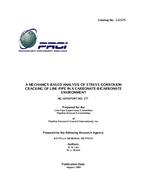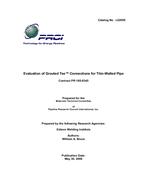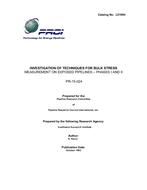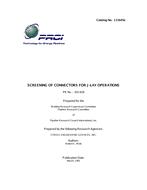Provide PDF Format
PRCI Report 177
- Mechanics-Based Analysis of Stress-Corrosion Cracking of Line-Pipe in a Carbonate-Bicarbonate Environment
- Report / Survey by Pipeline Research Council International, 08/01/1988
- Publisher: PRCI
$175.00$349.00
L51575e
Battelle Memorial Institute
Need: Stress-corrosion cracking (SCC) occurs occasionally in line-pipe steels. Reviews of this cracking indicate that the environment is carbonate-bicarbonate and that the cracking is primarily intergranular. Research sponsored by the PRCI Line Pipe Research Supervisory Committee (LPRSC) has over the years identified metallurgical and electrochemical parameters as playing a role in the process. This work has also argued the significance of strain rate and its relationship to the service loading, given that dissolution is indicated as the controlling mechanism. While much has been learned about the mechanism of cracking, very little has been learned about how to directly relate the nucleation and growth of cracks to the loading, the metallurgy, and the environmental parameters.
Benefit: The continual development of new line-pipe steels, the probable development of reliable in-line inspection (ILI) tools to detect SCC, and the occasional discovery of cracking colonies during field surveys have recently centered attention on methods to rank line-pipe resistance to SCC and characterize crack-growth rates. Ranking line-pipe resistance to SCC may be done in terms of a threshold stress for nucleation of SCC or the rate of crack growth at some crack depth beyond nucleation. Estimating remaining life of cracks located by an ILI tool or confirmed in a field survey involves only crack growth rate data or data that define a threshold stress for continued growth. Recent attention of the SCC subgroup of the LPRSC, therefore, has focussed on experimental protocols to assess susceptibility, determine thresholds, and establish growth rate behavior. The tapered-tension test (TTT) has been developed to determine stress thresholds for crack nucleation, whereas several different prenotched or precracked geometries have been or are now being used to assess crack growth. Attention has also focussed on modelling SCC thresholds and crack growth behavior so that data developed under laboratory conditions can be adapted to assess field cracking situations. Models are being explored for both threshold and crack-growth conditions. This report presents the development and validation for a model that is being adapted to line-pipe problems for the SCC subgroup. This model deals with the threshold for and the growth of SCC cracks up to about 0.020-inch deep
Result: The model appears to be consistent with the threshold cracking behavior for line-pipe steels in a carbonate-bicarbonate environment based on results for TTT specimens. The predicted and observed trends match well over the range of parameters studied. For the 7-day test, predicted trends for cracking seem to be controlled by the monotonic creep behavior. The ratcheting that occurs in the ensuing cycles has been reasonably accounted for by time-stepping onto sequential isochronous stress-strain curves. Consequently, the threshold for cracking in these short-term tests appears to be controlled by creep behavior.
Battelle Memorial Institute
Need: Stress-corrosion cracking (SCC) occurs occasionally in line-pipe steels. Reviews of this cracking indicate that the environment is carbonate-bicarbonate and that the cracking is primarily intergranular. Research sponsored by the PRCI Line Pipe Research Supervisory Committee (LPRSC) has over the years identified metallurgical and electrochemical parameters as playing a role in the process. This work has also argued the significance of strain rate and its relationship to the service loading, given that dissolution is indicated as the controlling mechanism. While much has been learned about the mechanism of cracking, very little has been learned about how to directly relate the nucleation and growth of cracks to the loading, the metallurgy, and the environmental parameters.
Benefit: The continual development of new line-pipe steels, the probable development of reliable in-line inspection (ILI) tools to detect SCC, and the occasional discovery of cracking colonies during field surveys have recently centered attention on methods to rank line-pipe resistance to SCC and characterize crack-growth rates. Ranking line-pipe resistance to SCC may be done in terms of a threshold stress for nucleation of SCC or the rate of crack growth at some crack depth beyond nucleation. Estimating remaining life of cracks located by an ILI tool or confirmed in a field survey involves only crack growth rate data or data that define a threshold stress for continued growth. Recent attention of the SCC subgroup of the LPRSC, therefore, has focussed on experimental protocols to assess susceptibility, determine thresholds, and establish growth rate behavior. The tapered-tension test (TTT) has been developed to determine stress thresholds for crack nucleation, whereas several different prenotched or precracked geometries have been or are now being used to assess crack growth. Attention has also focussed on modelling SCC thresholds and crack growth behavior so that data developed under laboratory conditions can be adapted to assess field cracking situations. Models are being explored for both threshold and crack-growth conditions. This report presents the development and validation for a model that is being adapted to line-pipe problems for the SCC subgroup. This model deals with the threshold for and the growth of SCC cracks up to about 0.020-inch deep
Result: The model appears to be consistent with the threshold cracking behavior for line-pipe steels in a carbonate-bicarbonate environment based on results for TTT specimens. The predicted and observed trends match well over the range of parameters studied. For the 7-day test, predicted trends for cracking seem to be controlled by the monotonic creep behavior. The ratcheting that occurs in the ensuing cycles has been reasonably accounted for by time-stepping onto sequential isochronous stress-strain curves. Consequently, the threshold for cracking in these short-term tests appears to be controlled by creep behavior.
Related Products
PRCI PR-15-024
Investigation of Techniques for Bulk Stress Measurement on Exposed Pipelines - Phases I and II..
$148.00 $295.00





